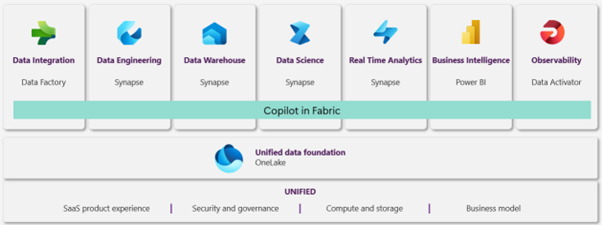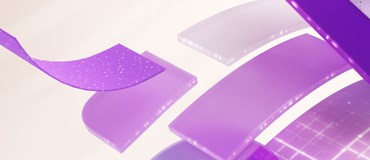The launch of Microsoft Fabric is enabling organisations to take their analytics platform to the next level. It is a complete data platform delivering a unified experience for analytics workloads from data integration to business intelligence, with the business intelligence component being Microsoft Power BI.
In this blog, we cover some of the common questions we get about Fabric and Power BI:
- How is Microsoft Fabric different to Microsoft Power BI?
- Is Microsoft Fabric replacing Microsoft Power BI?
- As a Power BI user, should I consider moving to Fabric?
- What are the advantages of Fabric for a Power BI user?
- Can I use Fabric if I have a Power BI licence?
- Can I migrate my Power BI reports to Fabric?
How is Microsoft Fabric different to Microsoft Power BI?
Microsoft Fabric is an end-to-end analytics platform offering a comprehensive range of data analytics experiences: data integration, data engineering, data warehouse, data science, real-time analytics, business intelligence, and data observability. Fabric brings all your analytics data and analytics tools into a unified experience.
Power BI is the business intelligence experience within Microsoft Fabric; within the Fabric platform, Power BI carries out the role of storyteller through data visualisations and dashboards. Ultimately, business users consume reports and data insights with Power BI.
Many organisations are already familiar with and use Power BI. It still works as a stand-alone Business Intelligence (BI) platform and can be used without the additional Fabric experiences.
However, Fabric with Power BI empowers all data professionals—data engineers, data scientists, business analysts, and business users who consume data via Power BI—to work together within Microsoft Fabric, yet each within their own role.
Is Microsoft Fabric replacing Microsoft Power BI?
Fabric is not replacing Power BI. Power BI has simply become one of the workloads of Fabric.
If we consider the analytics process from data ingestion to the visualisation stage, Power BI represents the data visualisation or Business Intelligence (BI) experience within Fabric. Being part of the Fabric experience enables deeper integration and additional features compared to being a standalone product.

As a Power BI user, should I consider moving to Fabric?
If you already use Power BI, Fabric offers many new capabilities. Power BI still has all the capabilities it had before, but Fabric adds to the experience.
If you use Power BI and have not encountered any scalability issues or complexities, you could continue doing what you are doing now. However, it is still worth familiarising yourself with what Fabric offers to know what is available if you encounter any limitations in new or existing projects.
Microsoft Fabric should be considered in situations where an organisation is considering implementing a data analytics platform. This may be due to an increasing volume and complexity of data or migrating existing data to the cloud.
For example, many years ago we implemented a Power BI reporting solution for a client directly over their data sources. As their organisation has grown, they are now experiencing issues with the scalability limits of that solution. Fabric allows them to meet their current requirements and flexibly scale their solution with additional data sources.
Another reason to consider moving to Fabric is to use the automated integration from Dynamics 365 applications into Fabric.
As requirements vary, please contact us to discuss your specific situation.
What are the advantages of Fabric for a Power BI user?
One place to store your analytics data in OneLake.
Fabric introduced OneLake, which is one place for all your organisational analytics data. OneLake has been dubbed the ‘OneDrive for analytics data’. Like OneDrive, which stores documents, OneLake is an enterprise-wide data lake that stores all organisational analytics data. It simplifies security, governance, and data discovery, enabling organisations to access the necessary data.
Direct Lake Mode
When setting up a Data Connection in Power BI, users can choose the Data Connectivity mode: import mode or direct query mode. Both methods have advantages and disadvantages. Fabric introduces the connection of Direct Lake Mode.
Direct Lake Mode moves the Power BI semantic model to the lakehouse so that Power BI queries data directly from OneLake. This enables fast query speed without having to copy any data. It takes the benefits of import mode (fast query speed) and direct query mode (not needing to reload your models) and combines them into one: Direct Lake Mode. Read more about Direct Lake Mode here.
Contact us to discuss your specific situation.
Dataflow Gen 2
Dataflow Gen 2 is the next generation of dataflows and offers the full Power Query experience that Power BI users are accustomed to, with new features and improved experiences such as:
- Simplified authoring including autosave and validations.
- Saving to data destinations accessible to non-Power BI users. Users of Microsoft Excel and other analytics tools can access dataflow tables.
- Triggering of dataflow refreshes within Fabric data pipelines, allowing dataflow refresh activities to be integrated with other co-dependent data ingestion and transformation activities.
- Enhanced compute engine for improved performance.
Watch a short demo of the new Dataflow Gen 2 in Microsoft Fabric.
Power BI, AI, and Copilot
Copilot in Power BI already helps with writing DAX measures, AI-enabled visuals, and Q&A.
With Fabric, you can enable the power of generative AI to get the most from your data. By enabling Copilot, you can use natural language to investigate and summarise data, suggest content, automatically create customised reports, and write DAX code.
Please note that Copilot in Fabric is currently only available on larger capacities.
Can I use Fabric if I have a Power BI licence?
Fabric is a capacity charge, so you need a Fabric capacity license to use the workloads. Generally, anyone creating and consuming a Power BI report will still require a Power BI Pro license. There is also a data storage charge for data within OneLake. You can read more about Fabric pricing here.
Please note that Fabric is purchased, provisioned, and configured at the organisation level. You may need to involve your IT function to start using Fabric. However, Fabric can suit all types of organisations, from small departments to large organisations.
Can I migrate my Power BI reports to Fabric?
Since Power BI is a workload of Fabric, in many circumstances your Power BI reports work in Fabric with little change. However, to take full advantage of new functionality or to make improvements to the overall reporting process, you may want to consider migrating your analytical data to Fabric and OneLake.
For example, if you want to consolidate your data models in Fabric to take advantage of OneLake, you will need to recreate your data integrations (ETL processes) to obtain, cleanse, and store the data readily available for use in Power BI reports.
We recommend reviewing your data strategy to incorporate any other benefits that the Fabric platform offers your organisation.
Are you looking to evolve your data strategy?
Schedule a free 90-minute consultation with us today.
Address your current data challenges and lay the foundation for leveraging data as a strategic asset for the long term.







